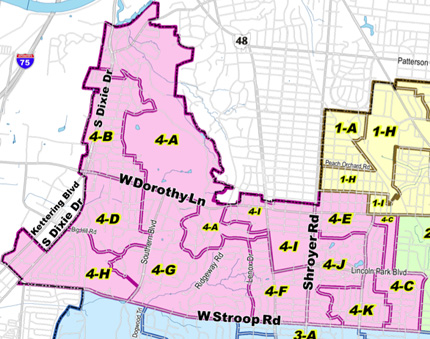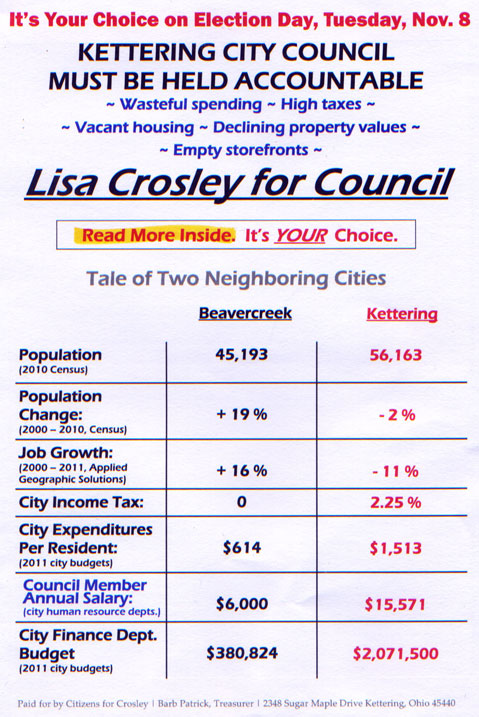In Kettering’s Ward 4, where I live, there is shaping up a very interesting race for City Council. Lisa Crosley is challenging Bruce Duke, the incumbent who has represented Ward 4 for 24 years. Mrs. Crosley is making specific proposals — including a gradual reduction of the city income tax from 2.25% to 1.5% — that, so far as I can tell, Mr. Duke has not yet responded to.
Today, I received a great campaign piece from Mrs. Crosley — a three color large envelop with printing outside (reproduced below). Inside contained a three color letter written on both sides. In her letter — see PDF of one side here — Mrs. Crosley makes specific proposals to revitalize Kettering. Her eighth point states, “By implementing the above proposals, we will lower the cost of government, create new jobs, and stabilize our population. This will allow a gradual and responsible reduction in our City income tax from 2.25% to 1.5% — while maintaining excellent essential public services.”
Each proposal is explained with several sentences, ending with a summary statement:
- Cut excessive council salaries — “Leadership starts at the top.”
- Stop out-of-control spending — “Better Stewardship is needed.”
- Implement term limits — “I strongly support term limits for council and mayor.”
- Create Transparency and Accountability — “I support open government.”
- Seek Collaboration — “I support creative cost-cutting.”
- Review Ordinances, Regulations — “I support a business-friendly Kettering.”
- Bolster Economic Development — “I support a vibrant private sector.”
- Reduce Taxes — “I support responsible tax reform.”
I am going to ask Mr. Duke to respond to these eight proposals, and I will post his response here.
On her web-site, Mrs. Crosley explains what motivated her to run. She writes it struck her as “distinctly un-American” that Mr. Duke was running unopposed. She writes, “Voters should have clear choices. That is the American way. … I believe that 24 years is long enough for any incumbent to serve. I believe it is time for New Leadership…and New Vision. I believe in citizen representation, and that local government must run like a business, not a political organization.”
Mrs. Crosley writes, “I believe government at all levels has become too big, is trying to solve problems it is not equipped to solve, and has assumed responsibilities better left to individuals and the private sector. Government is, too often, the problem, not the solution. In today’s troubled economic climate, we must commit to rational discussions on the role of government and the services it can reasonably be expected to provide. Government must cut costs to meet its income, not expect its citizens to bear increasing tax burdens.”
Mr. Duke’s web-site shows that is has the support of The Mayor of Kettering, Don Patterson; The Vice Mayor of Kettering, Tony Klepacz; Councilwoman, Amy Schrimpf; Former Congressman, Tony Hall; and the Kettering Professional Firefighters, IAFF 2150.
His web-site shows a list of accomplishments he is proud of in his 24 years of service on the City Council.




























